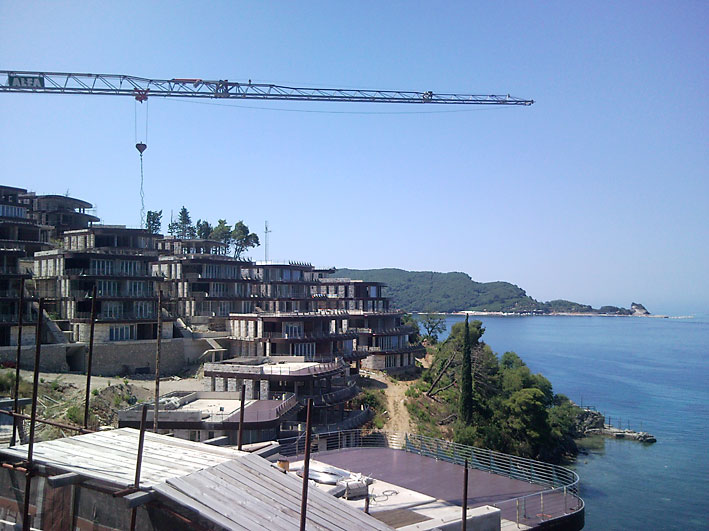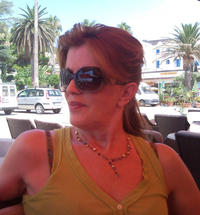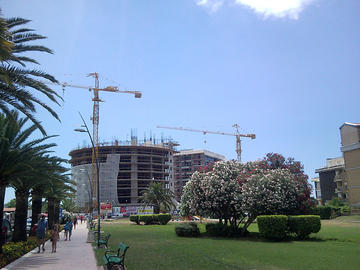
The buildings at Punta Zavala (photo L. Zanoni)
Despite the tragic experience of the 1979 earthquake and a signature on the Convention for the protection of the Mediterranean Sea by a country which defines itself an “Ecological State”, the Montenegro town of Budva risks being buried under cement. One after another planning regulations are leading to the model of Vancouver, “the city of towers”. Citizens' petitions are of no avail against rampant corruption
Branka Plamenac, journalist with the Montenegran weekly Monitor has written many of the journalistic inquiries exposing the speculation taking place on the Montenegran coast, particularly in the town of Budva, considered the tourist capital of Montenegro. Here we met her in July: at the entrance to the old town, sitting at the Café Mozart, Branka told us in detail how Budva risks being transformed into a town of skyscrapers, Vancouver style.
When did the building boom begin in Budva?
It began after Montenegro declared its independence following the referendum of 2006. At that time Montenegro was at the centre of international interests. In the first months of 2007 Russian investors arrived, and the boom took off. Official figures show however that the Russians were not actually the first investors; there were also many Irish and British with the Russians only in third place.
A lot of capital was circulating, not only foreign but mainly local – hidden under the cover of foreign capital – money accumulated during the war years, thanks to trafficking in cigarettes among other things. That money was invested in property. Then began the process of revising the planning regulations in order to build more. That was when the “Town Plan for the Budva Municipality” was adopted, the real culprit for everything that followed, because with the Town Plan building restrictions could be modified. Zones, which in previous plans were earmarked for quality tourism, which could not be urbanized, were lost. The whole ethos of a Mediterranean town was lost: parks, green oases, orchards, olive groves, all were transformed into areas for development.
The Plan embodies the greatest attack on Budva. It has devastated the land, from the beach at Jaz on the boder with the Kotor municipality, as far as the great beach of Buljarica, in the direction of Sutomore and Bar. The Barcellona Convention for the protection of the Mediterranean from pollution, which Montenegro signed and which does not allow building within 100 metres of the shore, has in no way been respected.
Then what happened?
Then followed the “General Town Plan” for part of the area in the municipality: for Budva and Becici. The previous plan was altered and the new plan permitted the present density. Where there had been houses with few storeys, permits were given for more storeys. Finally the controversial “Detailed Town Plan” (DUP) for the centre of Budva was passed. This is the one which regulates the most attractive part of Budva, the part between the main road to the sea and the beach at Mogren as far as Zavala Point.
This area had been preserved for years for high class tourism: hotels and such like. Budva, in fact, does not have a great number of hotels, but many private rooms. This area had been protected also under previous regulations.
At the beginning of the 70s experts from the United Nations had even arrived to draw up a plan, in collaboration with local experts, for the development of this area. In that plan it was all reserved for quality tourism and hotels. The rest of the town was to be kept as it was or restored. The plan was not approved. Then came the investment boom . . . .
Who is behind the Detailed Town Plan for the centre of Budva?
It can be seen as the plan of the builders' lobby, of the building mafia. Both local and foreign. All mixed with the worst kind of privatization, hotels and land sold cheaply. Entrepreneurs close to the Montenegran government.
The plan was passed by the local administration with the assent of the central government. It foresees Budva developing on the lines of the “city of towers”. It is actually written in the text: the model selected is the one of Vancouver.
A short time ago I published an inquiry into the DUP for the centre of Budva. I wrote what I am saying now. The article was taken up by Dan and Vijesti (two of the principal Montenegran daily papers, ndr.) and it created a real stir among the public. For them all this was incomprehensible: why Vancouver? If a model is really needed, why not choose a Mediterranean one?
When was the DUP adopted?
The DUP was adopted in 2008. The initial proposal was to allow building to 15-16 floors, then reduced to 13. In the area between where we are sitting (the entrance to the old town) and Zavala Point, buildings of these proportions could be constructed. And also beyond, including in the hills where few people live. This means among other things that no one even took into account the fact that Budva is in a zone of high earthquake risk.
If I'm not mistaken the famous earthquake was in 1979?
Exactly. It destroyed everything. The hotels in Slovenska Plaza collapsed like matchsticks.
And was the old town destroyed too?
Yes, entirely. Fortunately there were no victims. The old town was in ruins. It was in April, early on a Sunday morning.
After the disaster experts came from Japan. Studies were made which showed that in Budva 3 floors were the limit for building. That's how the complex in Slovenska Plaza was built, as you can see with a reduced height.
But all this does not interest the cement lobby. And take note, it's not about hotels, but buildings for sale. Budva is already full of appartments. There are about 4-5,000 appartments for sale. Budva has more appartments than inhabitants. It's bad for tourism too, because there are no more hotels, just private residences.
What kind of tourism is there at Budva?
There's not even a shadow of the high quality tourism that's needed. Just people who own appartments where they stay for one month a year or they rent out, often on the black market. The Council is not able to check all this out. In the whole of Montenegro there are about 300,000 private rooms and very few hotels. Budva is the prime example: few hotels and countless private rooms.
Have they already begun to build?
The DUP is operational, but meanwhile the world economic crisis has arisen and consequently the withdrawal of investors. The Russians too are abandonning this market because of the scandals and swindles which have taken place.
None of this, however, has had any effect on state and local units of government which have even modified the Plan adopted in 2008. They were not satisfied with 13 floors. Now the plan has been altered to include proper tower blocks of over 20 floors. Although the citizens were against it, it was signed by the Minister for Planning. The Minister was Branimir Gvozdenovic, now political secretary to the Party in government (DPS). In the meantime the Minister has changed.
Is the new Minister Predrag Sekulic?
Yes, but they have just changed seats. First Predrag Sekulic was Party secretary, now he's the Minister, while Gvozdenovic was the Minister and now he's the Party secretary. In any case, during the mandate of the present Minister the alterations to the Plan for central Budva will be carried out, leading to a great increase in the volume and height of buildings. In some places, where the owners are highly placed Party and government members, instead of 13 floors, buildings with 23 floors have been planned. So the middle of Budva, close to where we are sitting, will have twin towers. The Council has planned them to be built where at present there is a public nursery school which my children went to when they were small. The children are now being transferred.
But they haven't begun building yet?
Not yet, but meanwhile the ground is being prepared for them. The Council has sold that land to various businessmen, with highly controversial permits. All buildings which with the previous Plan were to rise to 6 or 7 floors, have been increased to 10, 11 or 12 floors etc. The whole Slovenska Plaza area has been altered in the Plan, raising the height of the buildings to 13 floors. For a total number of 22 skyscrapers.
Seeing the high earthquake risk, has there been a feasibility study?
There were people at that time who studied the situation, University Professors who after the earthquake advised against this. It was talked about. But nobody listened. The planners don't listen. As far as I know no serious study was made. At least in the area where I live and in which I take a great interest, this kind of study was not carried out. Partly because it could not give results to confirm that such high buildings could be constructed.
Who gives the permits?
The Minister. Branimir Gvozdenovic gave the go-ahead for these projects. He himself is building e centre of 3 skyscrapers to be called Tre Canne . You can see it on the website: “Only 100 metres from the sea” goes the advertisement. Luxury appartments only 100 metres from the coast.
What does the Morsko dobro, which is responsible for the coast, say?
The Morsko dobro, the public organization for the management and defence of maritime assets, conducts itself in such a way as not to upset the tycoons. You know how it works here, don't you? People work using the names of others. We know who's behind them, but we can't prove it because in the records other people figure as owners of the property.
The Morsko dobro does not meddle in questions where there are interests at stake. Why is Budva foundering? Because the interests of others have to be gratified. In the report I wrote for MANS it emerges clearly who are these tycoons Budva has to thank for this urbanization. They are people very close to the central government.
Let's take as an example the Atlas group which controls banks and a large number of businesses, one of the richest in Montenegro. The Atlas group, which is officially headed by Dusko Knezevic, has a permit to build on the beach at Mogren. You can see it on their website, the complex is called Mogren Garden. On a beach of rare natural beauty they want to build a skyscraper. It was to be 24 storeys high but let's say it was reduced to 11. But in addition to this building another of 16 storeys is planned for the hillside or rather the rocks.
Here too isn't anyone saying anything?
It's all within the competence of Morsko dobro, which hasn't taken any action. On the contrary, when in one of the public television debates the Morsko dobro spokesman was asked why that complex was planned on the beach at Mogren, he answered he knew nothing. It was ridiculous – that project was easily visible on the Council website. The inhabitants of Budva cannot understand who could think of doing such a thing.
How do the local people react?
Some of the townspeople of Budva are dissatisfied and have signed a petition.
But nobody is protesting?
Look, here no one bothers until their own interests are involved. No one goes to see the plans until they touch something that touches them directly. They mgo to see if they have been given something, everybody has been given something. Do you know what they have done to pacify the people?
First of all they increase the volume allowed on new buildings, so anyone having land gains something.
Secondly they allow an increase in volume for existing houses, even if the owners haven't applied for it. This happened to me. I've been given permission to raise my house to 5 floors. They don't stick to certain areas but all of them, in order to justify the skyscrapers on the coast. So they think everyone is satisfied, but in reality it isn't the case.
In my area, for example, we've organized a petition and collected 200 signatures to reduce the height of the buildings. We sent our request to the Prime Minister, Igor Luksic, and the Minister Predrag Sekulic …. but we never even got an answer. Or rather the Prme Minister said that the plan had been authorized even by the Constitutional Court, because some of the people of Budvahad appealed stating that the Plan for Budva did not comply with the General Plan. The Constitutional Court confirmed that all was correct and that was the end of the story.
Furthermore all gets planned after the public debate. The people see one thing and then the administration does another, the plan disappears then comes back to light after it has been approved and become law. And when the planning tkes place after the public debate, that's when the corruption happens. Everything goes through the Department of Architecture at the University in Belgrade. The leader of the team for planning is Professor Miodrag Ralevic, against whom many accusations of corruption have been lodged with the Magistrates at Kotor. Now, according to the information I have, the Magistrates at Kotor are thinking of launching an investigation to clarify how the Plan for the centre of Budva was arrived at. We no longer know who to turn to. This Plan should be outlawed to save Budva.
This year is the twentieth anniversary of when Montenegro declared itself an “Ecological State”. A small country but of extraordinary beauty with many still unspoilt natural areas. Don't you think little would be needed to keep it at a high level, to develop it in a sustainable, respectful manner?
Montenegro only develops in one way: the money accumulated during the contrband trafficking of cigarettes then invested in foreign banks, particularly in Cyprus, returns to the country and is recycled in construction. Ecology holds absolutely no interest for these people. The so-called “Ecological State of Montenegro” is very far from the concept of a state which intervenes to protect its environment and therefore its own citizens.










